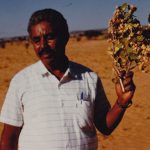Boscia senegalensis
Uses
Burkina-Faso (Bourzanga, Bam Province): The Mossi people eat the seeds alone – dry or soaked in water, after the pulp has been removed. The seeds are also mixed – dry or soaked – with beans, couscous or rice. The interior bark is boiled in water to give a sweet taste to millet flour. [NB MORSE writes that it is much sought after plant in times of famine; however, it is not clear which, if any of these uses was common to famine use. Sudan (western and northern regions, Kordofan, Darfur): after being husked, the pea-like seed – a berry – is left. These can be eaten raw, but are very acid and are usually consumed after lengthy preparations and cooking. The berries are dried in the sun, pounded to remove the outer seedcoat and soaked again for several days. If the water is changed often, only two days’ soaking is necessary (it is reportedly soaked for 5-7 days to remove toxins). The seeds are boiled in a cauldron with local potash, then soaked in cold water to remove it and finally mixed with salt and butter for serving. Mukheit is ‘sweetened’ by removing the hull, debittered after seven days’ soaking with the water (to which Kambo, or potassium carbonate is added) changed daily. The seeds are then sun-dried before cooking. Balilah is made from Mukheit by boiling the seeds with oil and salt. When they become soft, they are then eaten. Chad (central): fruit [sic] eaten. Nigeria (Kano State, northern): berries eaten.
For details regarding nutritional composition, see Kim et al
Additional Information
- Name Authority:
- Hochst. ex Walp; Pers. Lam. ex Poir.
- Vernaculars:
- Burkina Faso (Mossi): Lamboèga. Burkina Faso (Mossi): Lamboèga. Sudan (Arabic): Mukhait, Mukheit, Aisen, Korsan. Chad (central) - (Arabic): Mekhet. Nigeria - (Hausa): Hanza; (Kanuri): Tabila. Sudan (Arabic): Mukhait, Mukheit, Aisen, Korsan. Chad (central) - (Arabic): Mekhet. Nigeria - Hausa: Hanza. Kanuri: Tabila. Niger: anza
- Misc:
- Chemical composition (after Berry-Koch) (g/mg/mcg per 100g) (dried): Protein = 21g. Fat = 1.6g. Calcium = 123mg. Fe = 6.8mg. Beta carotene = 165mg Vitamin B1 = .02mg. Vitamin B2 = .03mg. Niacin = 8.8mg. Vitamin C = 5mg. Kcal = 341; (cooked): Protein = 5.4g. Fat = 0.2g. Calcium = 33mg. Fe = 2.8mg. Beta carotene = 25mcg. Vitamin B1 = .01mg. Kcal = 92. (after Abdelmuti) (un- debittered): Protein (crude) = 29.3%. Oil = 0.7%. Ash = 3.5%. Fibre (crude) = 2.7%. Carbohydrate (soluble) (starch) = 39.5%; (sugars): Sucrose = 4.3%. D-glucose = 0.2%. D-fructose = 0.7%. Amino acids (g [16g N]-1): Aspartic acid = 7.7g. Threonine = 1.7g. Serine = 2.3g. Glutamic acid = 9.0g. Proline = 6.5g. Glycine = 3.5g. Alanine = 3.2g. Valine = 4.5g. Cysteine (performic acid oxidation) = 1.3g. Methionine (performic acid oxidation) = 1.8g. Isolelucine = 2.9g. Leucine = 7.0g. Tyrosine = 2.3g. Histidine = 1.3g. Lysine = 1.5g. Arginine = 15.1g. Minerals: Sulphur = 2.20mg/kg-1 (dry). Potassium = 0.15%-1 (dry). Magnesium = 0.10% (dry). Calcium = 0.14% (dry). Na = 0.01% (dry). K = 1.03mg/kg-% (dry). Zinc = 42mg/kg-1 (dry). Iron = 10.5mg/kg-1 (dry). Manganese = 17mg/kg-1 (dry). Copper = 8mg/kg-1 (dry). [N.B. for values of various de-bittered forms, see Abdelmuti]. Ethnomedical uses - Sudan (eastern area): berries reported used as a diuretic in the treatment of syphilis, and an infusion of leaf-extract used as an eye wash. Powdered leaves and berries applied as dressing for chronic ulcers.

